Welford Remembers
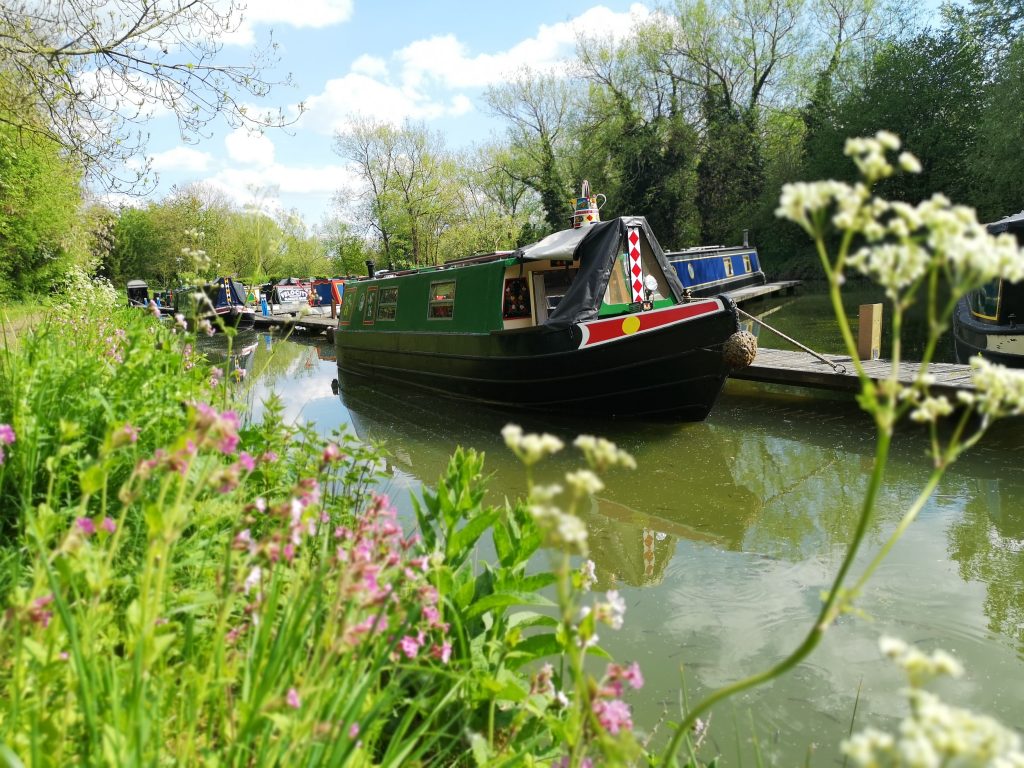
This past weekend marked 50 years since the Welford Arm was re-opened in 1969 after 13 years of abandonment and vandalism which began in 1946. In May 1969 Sir Frank Price, chair of the British Waterways Board and boat-owner came to Welford to mark this momentous occasion. The restoration saw the beginning of a new era for the canals – with their primary use moving from industrial haulage to leisure use. As regular readers will know Welford marina has been Pea Green’s home mooring since I bought her in 2016.
Ladybird influence
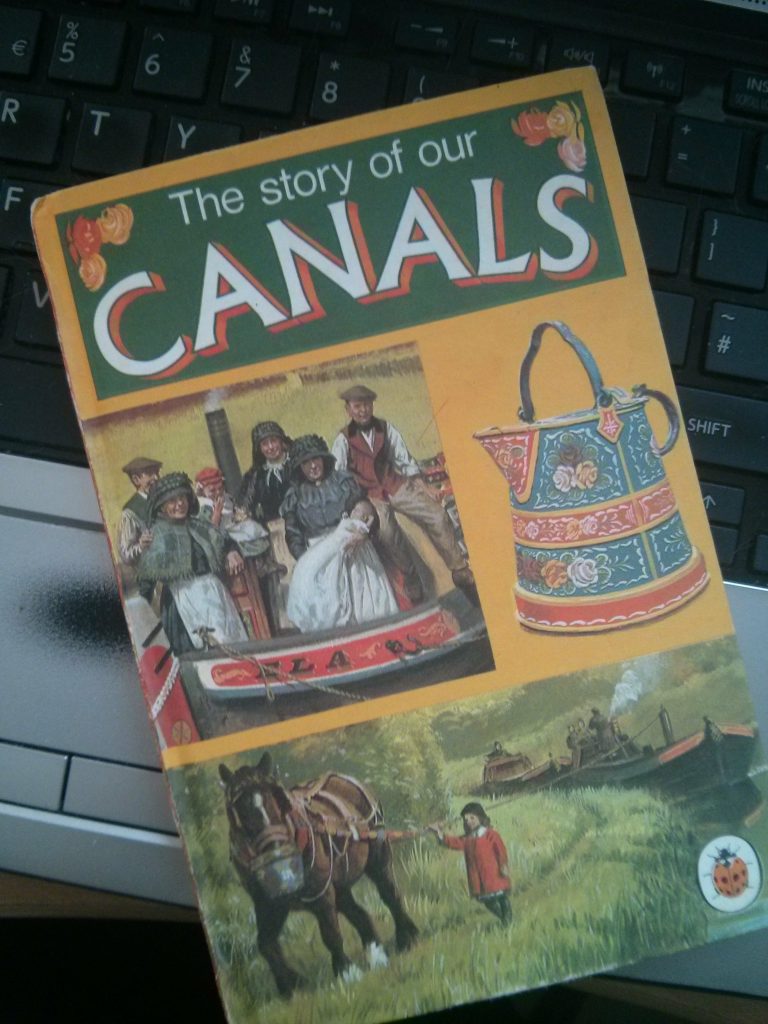
When I found this lovely spot, I had no idea of the history of the Welford Arm, nor its importance in contemporary canal history. I knew a bit about the history of canals as a social historian and, of course, I had read the Ladybird book ‘The Story of Our Canals’ as a child. (In fact, my entire canal knowledge was based on this book when I bought my boat.) So, although I could spot a jaunty canal woman’s bonnet I knew little about the UK’s canal renaissance in the second half of the 20th Century.
The importance of the 60s
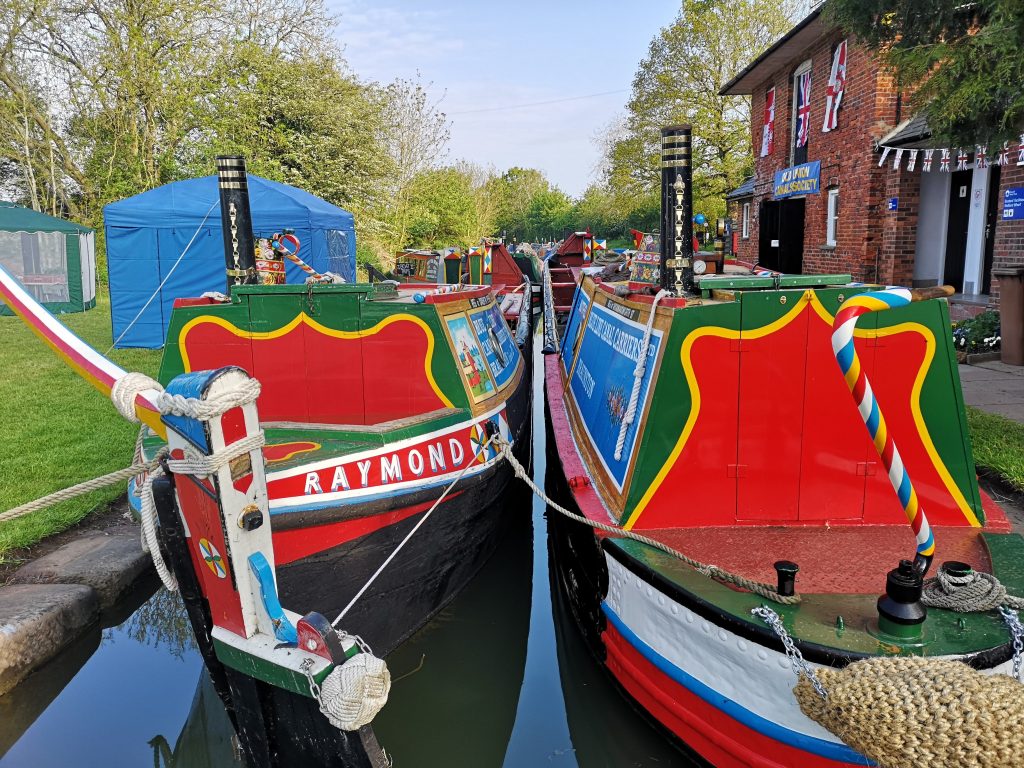
I don’t think I am alone in knowing little about the shift to leisure boating. The more I have learnt about the recent history of Welford the more I have come to realise that all too often canal heritage focuses on the building of the canals in the late 18th and early 19th Centuries. (Or even worse compresses and merges events that took place over a two-hundred year period.) The contemporary history of the canals’ decline and later renaissance is often a footnote or ignored completely. Even when the restoration work of the 60s is commemorated it too becomes consumed in canal history from earlier times – this can be seen in the commemorative events at Welford.
Canal nationalisation
The mid to late 20th Century saw the canals taken into government ownership. Firstly, during the Second World War when the canals ere used to carry heavy goods, with boats sometimes crewed by conscripted women. When the war ended the canals returned to private ownership, but in 1947, along with the railways, they were nationalised once more.
Demise of the Welford Arm
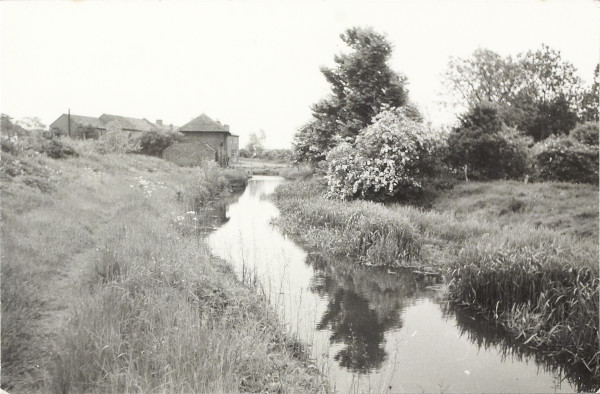
The 1947 Transport Act saw the establishment of the British Transport Commission (BTC). Company owned carrying boats passed into government ownership and some less frequented canals, including Welford, which first opened in 1814, were abandoned. There was no official closure of the Welford Arm, but by 1946 it had fallen into disuse. The limekilns at the Welford Wharf had stopped production in the 1930s and coal haulage down the arm had also decreased. I am sure the hard winter of 1945-46 added to the desertion as the canal was frozen over.
Moving to the roads
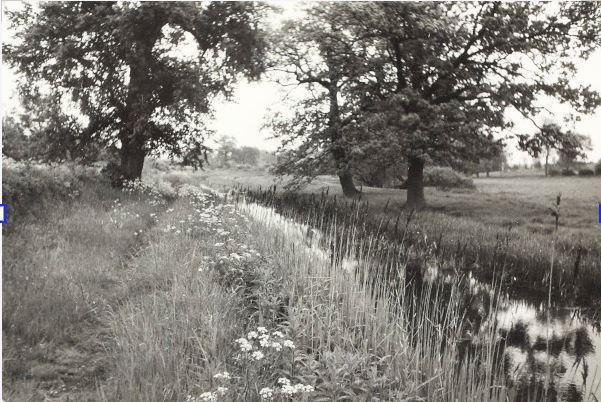
The final death knell for canal haulage came during the 1960s. Government disinterest and a lack of investment led to further abandonments. Add to this the arctic winter of 1962-63 -when the canals froze over for weeks at a time, a new growing motorway system-ideal for heavy goods haulage, and the canal network appeared to be on the verge of totally disappearing. One of the first acts of the British Waterways Board, (formerly the British Transport Commission) was to stop most canal haulage. Photos taken in the late 1950s at Welford show an already weed-ridden waterway and dilapidated buildings, reflecting how quickly unused canals fall into disrepair.
Inland Waterways Association and the Minister
By the late 60s, with another transport act on the cards, it looked as though it was only a matter of time until the canals would disappear for good. However, the campaigning work of the Inland Waterways Association and others, influenced key government ministers. Most notably the Minister for Transport – Barbara Castle.
Saving the canals

Castle, who had taken a holiday on the waterways was appalled at the Treasury’s suggested financial cuts to the canals. She became an advocate for the waterways, and had the foresight to recognise a long term leisure use for the UK’s waterways. Castle opposed the financial cuts and devised three categories of canals. Canals were put into one of three categories a) those continuing to be use used for freight, b) cruising or leisure canals, c) ‘remainder’ canals. The latter would be maintained to a minimal level for safety and might be restored by voluntary groups. Although the categorisation did not save every single canal it did ensure a future for the many of England’s canals. Castle’s July 1967 cabinet memo and reports produced by the Waterways Board set a plan in action to protect and save the waterways.
Abandonment
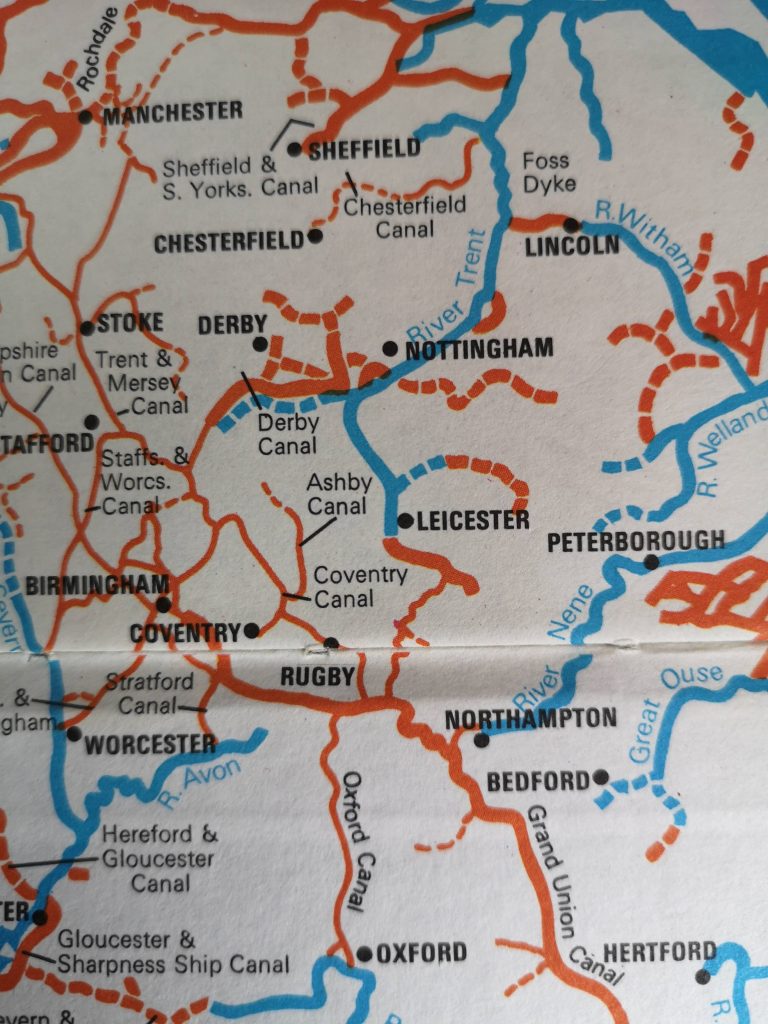
All of this was well and good, but for likes of the Welford Arm it could have meant their total disappearance. My 1970s copy of the Ladybird ‘The Story of our canals’ reflects this decline, with a sad looking map on the back endpaper marking disused or lost canals. As a child I was fascinated by this map, I think the idea of ‘lost canals’ conjured up ideas of treasure or great places for a ghost story, rather than weed-ridden waterways.
Saving the Arm
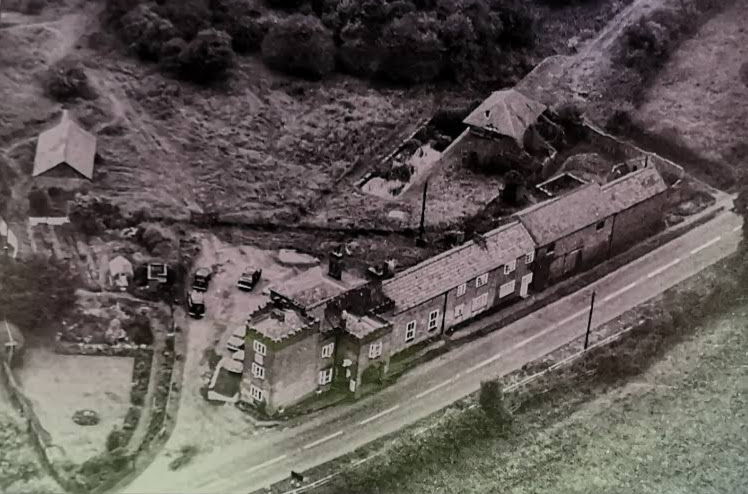
By the time of the 1968 Transport Act the Welford Arm had almost disappeared from view but unlike some other ‘remainder’ canals things were looking up for the 1 ¾ mile Welford Arm. The formation of the Old Union Canals Society in 1964 brought together a group of enthusiasts keen to take on a practical challenge – the re-opening of the Welford Arm.
Dredging needed
In August 1964 the Harborough Advertiser ran an article describing the initial surveys by boat of the Welford Arm. In places the water was only about 1 m (or 3 feet and a bit deep) the survey boat dragged along the bottom. This suggested the need for extensive dredging before the canal would be navigable again. I learnt at the weekend that the first exploration had taken place in 1961 when a lawyer from Market Harborough attempted to bring his boat along the over-grown canal.
Why the Welford Arm?
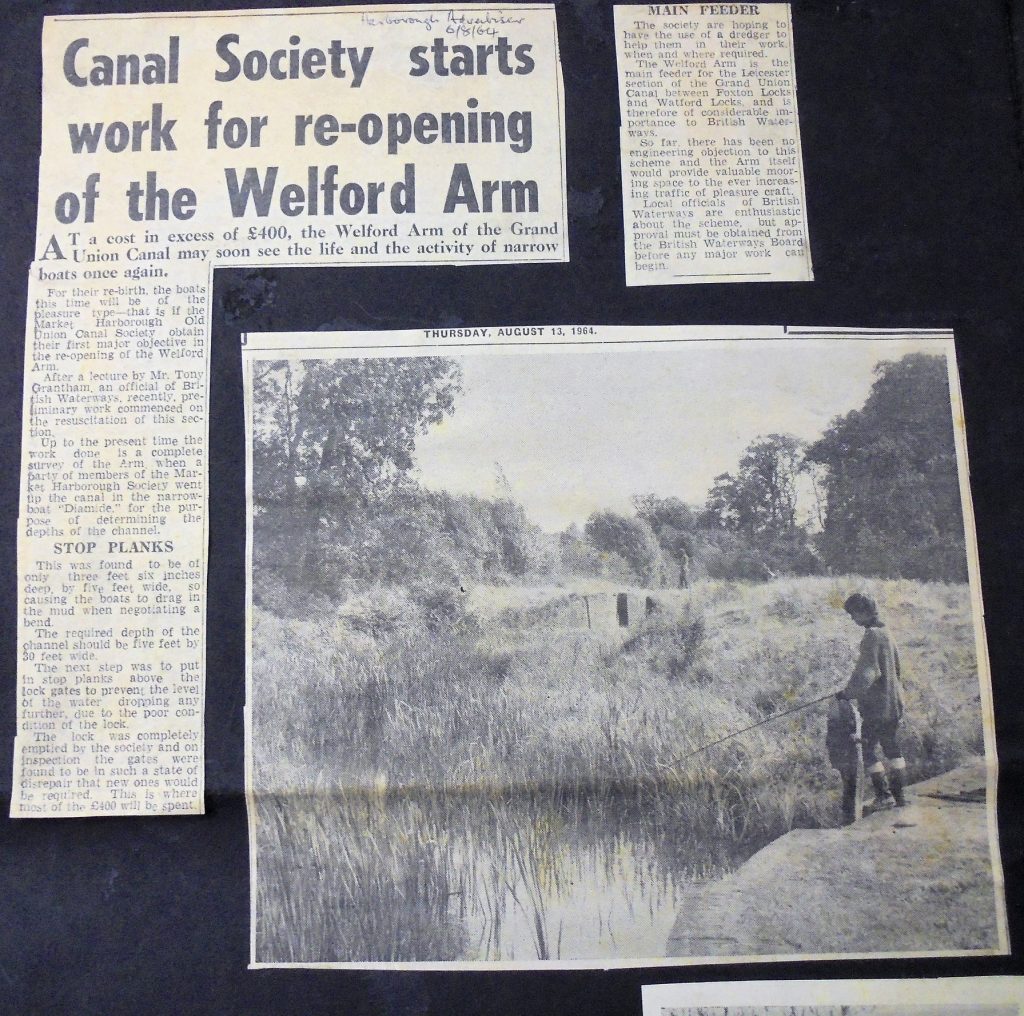
Some might be wondering why the Welford Arm mattered, after all it is a dead-end that arrives in a small village. The arm is though significant for other reasons. As identified in that 1964 newspaper article, the Welford Arm served an important engineering purpose, as it acts as a feeder canal. Water from the local reservoirs goes down the Welford Arm to feed the main Leicester Line of the Grand Union. Without the water from the reservoirs much of the Leicester Line would be without water and fall into disuse.
A cunning plan
Equally as important to the Welford Arm was the newly developing leisure industry on the canals. The arm had long seen any trade disappear and its only real use going forwards would be leisure boats, either privately owned or part of the new hire-boat fleets. The British Waterways also recognised that these stretches of canal could be important for in-line moorings as more leisure craft hit the waterways.
A new breed of boat
This new leisure role for old industrial waterways was still in its infancy in the 1960s. The early leisure boats were often old working boats, cut down to make more manageable craft. Some re-worked boats had caravan style living areas built on the boats, or canvas shelters extending over the old cargo area. Boat builders also had to shift their focus or go out of business. At Braunston the early leisure boats continued to be built with a British steel hull then sideways launched into the canal, before having their wooden tops added. My boat, was one of those early Braunston boats, number 26 emerged from the boat yard in 1973.
Welford Arm May 1969
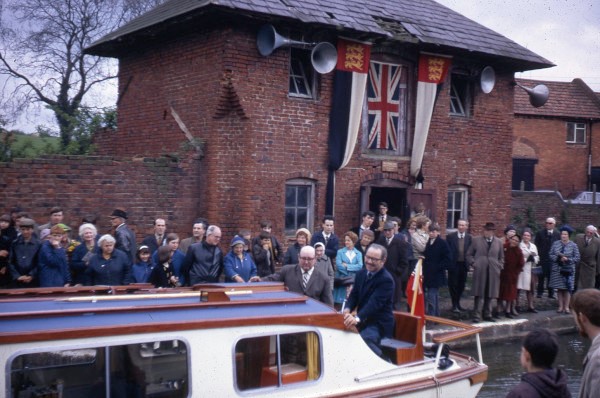
Only 5 years after the Harborough Advertiser reported the initial plans for the Welford Arm the work was completed and official re-opening took place on 17th May 1969. The bridge at the lock has a plaque marking British Waterway’s Chair, Sir Frank Price’s re-opening the arm. In the preceding months the canal had had 10,000 tonnes of mud removed, new lock gates and two new bridges. Much of the restoration was undertaken by the British Waterways Board with the support of the Old Union Canals Society. Pictures from the 17th May 1969 show a new leisure boat, Sir Frank’s own boat ‘Telford,’ in the canal’s finger-end, on the towpath are a crowd of visitors – some wearing fabulous hats and large Union Jack flying from the old wharf building. It was these events that began the renaissance of the canal at Welford.
Welford Arm – a golden future
With the Welford Arm once more open for business it wasn’t long before the British Waterways Board paid a visit. In 1970 they assessed whether the arm should stay a ‘remainder’ canal or be upgraded to cruising status. In a report sent to the Environment Secretary in 1974 it was recommended that the arm should be upgraded. This was not just a goodwill gesture, but rather the earning power of the Welford Arm had been identified, ‘providing an additional boating centre off the mainline of the canal’.
Hire-boats
Since then the Welford Arm has continued to flourish. For a while it was home to a fleet of Black Prince hireboats and a working boatyard. A marina was dug near the finger-end and later a second marina in a spot that had been used for clay extraction. This former clay-pit is now where Pea Green is moored
Misplaced focus?
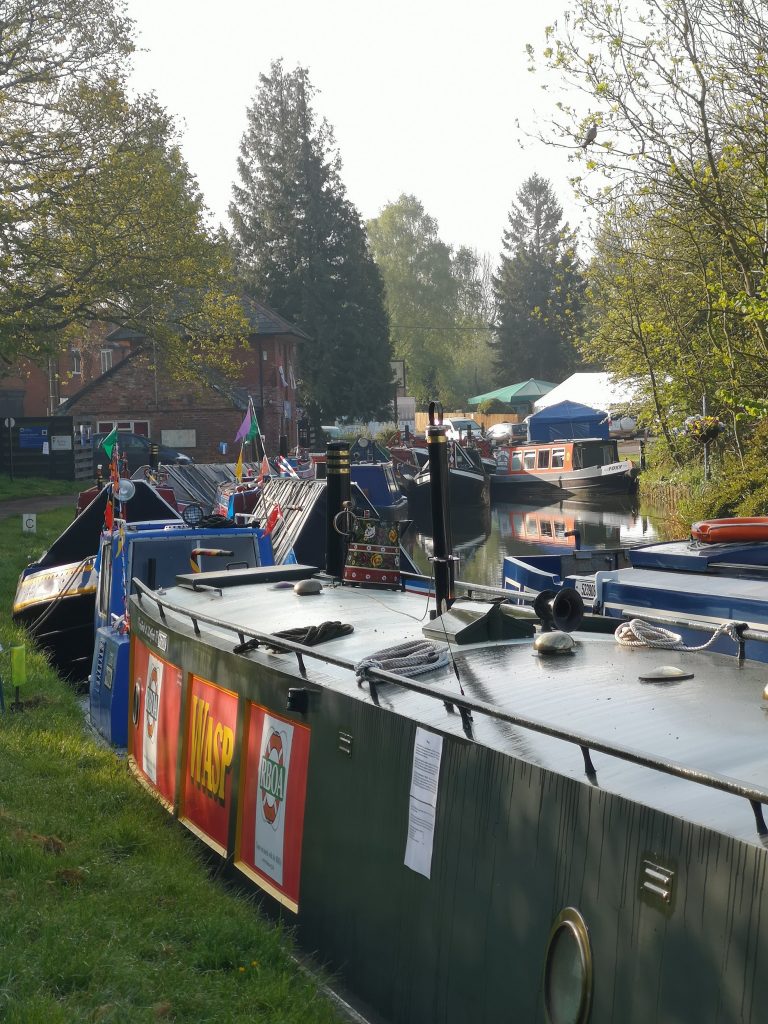
The weekend has marked an important moment in the history of the Welford Arm, though some might have thought the watery focus was misplaced. After all in 1969 the boats focused on the new leisure craft. However, during the past weekend the wharf harked back to a much earlier time. It was filled with historic narrowboats, all of which anachronistically pre-date the restoration of the arm, and were built for canal haulage. Interesting though these boats are it did seem to miss the point of the weekend’s commemorative focus – the advent of a new era of canal use by leisure boats. It is an irony that the very boats which disappeared and led to the Welford Arm’s decline are were the ones being celebrated at an event marking the new leisure era of the canals. Sadly, no early leisure boats – like Sir Frank Price’s fabulous looking cruiser – were included in the celebrations.
Bad historical memory
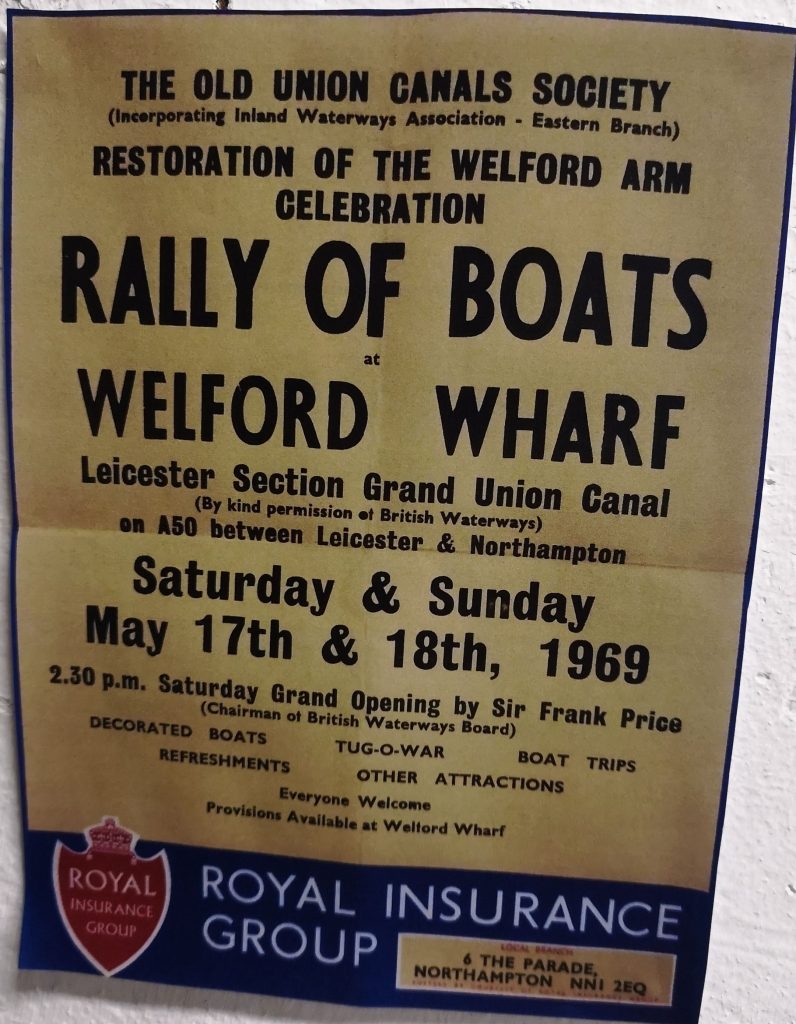
At best the focus on early 20th Century working boats seemed a missed opportunity and at worst an example of poor history at work. For most this anachronism probably went unnoticed, but I wonder what members of the public understood of the event they attended? Even some local businesses advertised the events as the ‘opening of the arm’ which actually happened in 1814. As someone who has spent a career in historical site interpretation, I can’t help but feel frustrated. Such continuing inaccuracies and misconceptions seem to further contribute to a poor understanding of the past, and the significance of the Welford Arm’s restoration and the important roles of local men and women along with the likes of Barbara Castle and Frank Price.
Again an informative blog. i agree that people are so often unaware of the historic accuracy , or not , of what they are seeing . but let us be grateful that they are prepared to show an interest and get out and learn something ! cheers !
Haha! Yes you are right, but I just wonder what wretched version of history the take away! ??
A very interesting and informative blog once again Kay.
I agree with your comments, though I suppose the main point is that it was at least celebrated to mark all the hard work that was undertaken in the restoration of the arm.
Clive, yes you are right, I a guess I just wonder if bad history and commemoration is better than none! But then I spent 17years working in a field where this was a big question ?
Chuckle.
It turns out that my narrowboat “Drake” was the only boat present in this years 50th anniversary that was present in 1969! I didn’t find this out till after the event when one of the gentleman who had put a display together for that weekend found an old picture of the 1969 event. Lo and behold in the background was a very distinctive 72 footer! Painted in red as opposed to her present day grey!
Brilliant! You were clearly on the legit boat ??. Whereabouts were you moored? Am trying to place your boat. Drake should have had pride of place in the finger end!
Just beside the entrance to the car park! She had a skull and crossbones flying up till the point of the celebration!
Ah right ? you should have been the star attraction ????
More please. . .I’ve sent several friends over to read your blogs. We are all fans. Please continue to share your narrowboat adventures with us. Weather keeps me from flying across the US and into UK to shop for my very own NB. So looking forward to sharing in the adventure.
Ah thank you! So sorry I have been a bit slow writing recently! I took Pea Green on a 10 week trip over the summer and have been trying to catch up ever since. More soon, I promise!
Wonderful to read this article,
I was interested to be reminded that Barbara Castle was the instigator and got the backing to get the ball rolling going forward for this wonderful leisure industry.
My family (grandmother, great grandparents) were the millers on the Welford basin……… I believe that there are only a small foundation of the bricks left to show where the mill was. It finally fell into disrepair having been abandoned in the early part of the century 1900’s
Your article brought back memories for me, knowing my history thank you……..
And what a busy busy place it all was and is once more…….
Thank you so much for commenting and also for the info about your family. I did a post on Instagram earlier this year that had more detail about the mill next to the lock, which I think is where you mean? If you want to email me kayandrews2102@gmail.com I can send you screen shots of the post, if you don’t do I insta. Was your family’s last name Harold? Kay
Hi My family started a hire business at Welford Marina in 1975/6. We were Mardyke Marine. We had a fleet of 4 narrow boats. I think prior to Black Prince, I believe. We had to move our fleet to Rugby due to the draught but came back for a brief time before then moving to Weedon. Our fleet colour were red, green and yellow. I still have a few old brochure. Our fleet were named after Essex rivers, due to us coming from Essex. We lived in Sibbertoft, in the village school, we were the first owners of the school. Our boats were called Colne, Roding, Chelmer and Pyefleet. I hope this helps to add to the wonderful history of the Welford arm. My brother and I had a lot of fun there, fishing, old bottle digging at the dump and exploring whilst our parents ran the hire business.
Eve
Thank you so much for sharing your memories. They really add an extra layer of history to the Welford arm
Kay